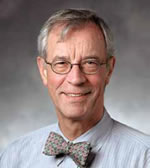Professor of Medicine, Chief, Division of Blood and Marrow Transplantation, Stanford University
Karl Blume, a pillar of the bone marrow transplant community and the American Society of Hematology, died January 9, 2013. Although he had endured a long illness, his death was unexpected.
Karl received his medical education at the University of Freiburg, Germany. An early interest in abnormalities of red cell enzymes led him to work with Dr. Ernest Beutler at City of Hope National Medical Center in Duarte, CA, from 1971 to 1972. That mentor-mentee relationship blossomed particularly, and Karl and Ernie became life-long friends. Upon returning to Freiburg, Karl’s clinical responsibilities included managing patients with acute leukemia. The high mortality rate that inevitably accompanied disease relapse caused Karl to rethink the direction of his career path, and the change in trajectory became fixed after a fortuitous one-day visit to Fred Hutchinson Cancer Research Center in Seattle, WA, in 1974. There, Karl met Dr. Donnall Thomas and became convinced of the concept of marrow ablative chemotherapy followed by bone marrow rescue as a mechanism for curing patients with acute leukemia. In 1975, Karl was recruited to City of Hope by Dr. Beutler to develop a bone marrow transplant program. At that time, bone marrow transplantation was being performed at only a few institutions, and as a pioneer in the field, Karl interacted frequently with colleagues at the Fred Hutchinson Cancer Research Center and, in the process, developed a number of enduring friendships. When the program at the City of Hope began, times were a bit shaky, and Karl once showed me a letter that he received from hospital administration stating that, because he was doing such a good job, they had decided to continue the transplant program for another six months. The administrators’ judgment proved prescient, and Karl went on to lead the City of Hope program to international prominence. He was particularly proud of the young physician-scientists he mentored there, most notably Steve Forman, who took over the program after Karl was recruited to Stanford and who continues to lead that exemplary group.
Karl was recruited to Stanford in 1987 by Dr. Stanley Schrier and Dr. Ronald Levy. They tell the story that when they went to City of Hope to interview him for the position, Karl immediately took control of the meeting and described his vision of a bone marrow transplant program at Stanford. Karl recruited Nelson Chao and me to his team, and we shared every third night call. Those were heady times, filled with new ideas and difficult challenges. Karl was a charismatic, visionary leader who saw the importance of including all members of the patient care team (nurses, social workers, dieticians, physical therapists) in management planning. This team-based treatment model was new at Stanford at the time, but the concept is now widely emulated. Nelson went on to become the head of transplant at Duke University, and that program has thrived under his leadership. Therefore, Karl contributed to development of three of the major bone marrow transplant programs in the United States and, in the process, mentored a number of fellows who have made important, independent contributions to hematology.
In 2003, late in his academic career and after stepping down as Division Chief, Karl took on the formidable challenge of developing a National Cancer Institute (NCI)-designated Cancer Center at Stanford. Working with Dr. Beverly Mitchell and with the cooperation of colleagues from throughout the Medical Center and the University, an outstanding group of clinicians and investigators was assembled, and NCI designation was awarded in three years.
Karl was known for his dedication, discipline, compassion, and sense of humor. He was a particular fan of Stanford sports and knew at all times the updated scores of the competition for the Directors’ Cup that is awarded annually to the top intercollegiate athletic program in the nation. Karl was a forceful and effective mentor and took great pride in his mentees’ accomplishments. He was a driving force behind both development of the American Society of Blood and Marrow Transplantation (ASBMT) and creation of Biology of Blood and Marrow Transplantation, the official journal of that society, serving as its first co-editor. Karl became the first honorary member of ASBMT. He was devoted to the American Society of Hematology, serving as the first chair of the Development Committee and serving on the Executive Committee. He was also a member of the Scientific Committee on Transplantation Biology. Karl received many awards and honors both in the United States and Germany, but his legacy is the impact he had on the thousands of patients that he treated and the hundreds of students and trainees that he mentored.

